12 - Interior planterbeds for passive heat storage in an attached greenhouse
Planterbeds and attached greenhouses are the heart of any HTM passive solar house plan. Along with green, growing plants there come benefits both practical and spiritual. Sloped glass gives an HTM its unconventional look, but vertical glass simply does not produce as much solar heat gain or allow you to grow crops indoors. Indoor planterbeds and the ability to grow crops year-round in extreme climates is the hallmark of our sustainable design. Sub-surface drip irrigation is the norm for any planterbed, as it gets water directly to the root zone without need to sodden all the soil. Watering from the surface is possible, but usually limited to outdoor planterbeds or low humidity climates where the extra water evaporating indoors would not be intrusive. For instance, here in the high country our winter humidity is lucky to be 30%, with surface watering, we can easily raise that to 50%, or more. And we can do it passively without electricity, filters, and machines. Proper humidity levels are healthy for your skin and body, protecting much more than just your furniture.
All fixed vertical and sloped windows along the south facing planterbed and clerestory thermopane units should be at least 1 inch overall (two 3/16 inch glass with a 5/8 inch gap) or 7/8 inch overall (two 1/8 inch glass with a 5/8 inch gap). More than a 3/4 inch gap can lead to energy robbing convection currents within the space. Less than a 5/8 inch gap can more easily allow conductive heat/cooling loss. Residential windows are generally thinner, less effective against heat/cold transmission, more delicately vacuum sealed, not as well tempered and more prone to condensation problems. Patio door replacement glass, for instance, is marginal for vertical windows, but unsuited for sloped applications. Buy thicker, commercial 3/16 inch thick tempered glass thermopane units, commonly sold as commercial store window glass. Using commercial components is one key to saving money while building a home. Your local Quik Stop, gas station, or warehouse was much cheaper to build than any residential home, yet was built with heavy-duty components, block walls, industrial tile, big laminated windows, and large handicapped bathrooms. Technologically advanced inert gas filled super-insulated UV sensitive windows are available, but cost-versus-benefit and longevity are questionable.
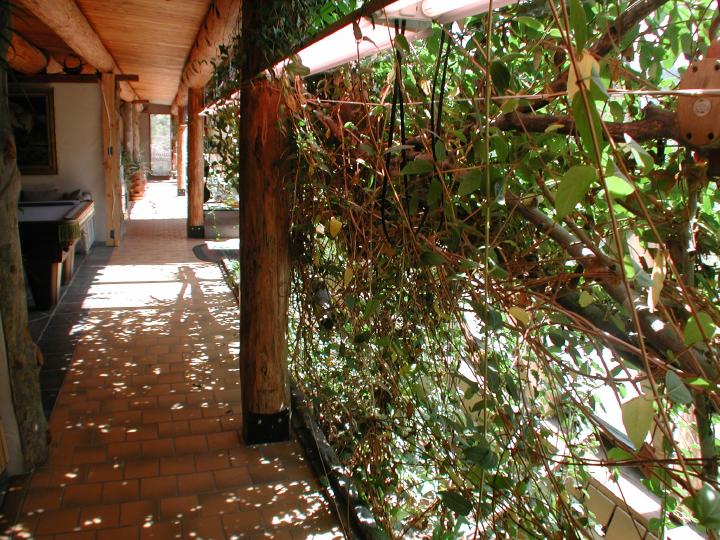
South walls with the planterbed and sloped glass are nice because you don't really lose any floorspace. The sloped glass could not be walked under anyway. The large expanse of glass really brings the outside in creating the feeling of a much larger structure and increasing the view potential dramatically. If you find the energy loss from so much glass challenging, insulated drapes are a very effective design option that we highly recommend. Basic commercial thermopane glazing units with a traditional vacuum seal provide maximum UV transmittance (solar gain) with a very respectable R rating (insulation). With the exception of North side windows, where there is little or no direct light, we tend to avoid argon gas filled thermal windows, low-e and other expensive technological marketing gimmicks.
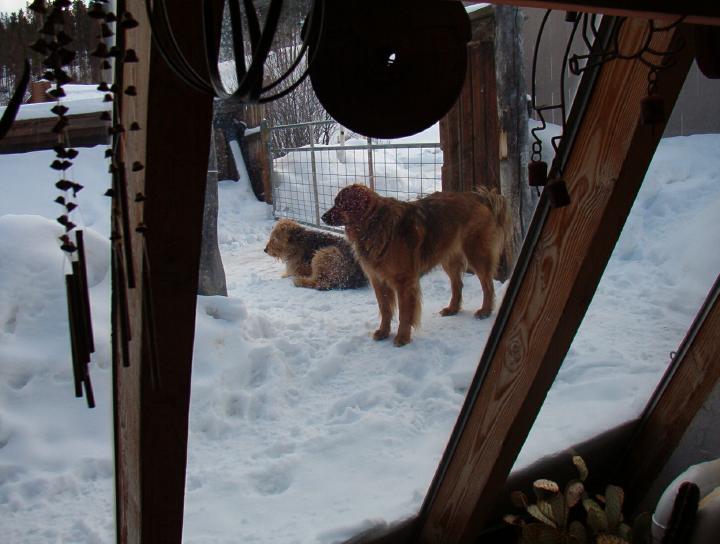
Indoor planterbeds perform many functions besides being just a great hobby. The staggering volume of wet earth in these planterbeds holds an amazing amount of energy for cooling or heating purposes. This is one of the keys to high thermal mass housing: energy storage. The other main benefit from having indoor planterbeds is the humidity to be gained from plant evapo-transpiration. Mechanical humidifiers are well known for their stale water and problems with bacterial transmission. Plants provide plenty of natural humidification and air filtration without any need to worry about how pure it is and totally without need for electricity. Proper levels of humidity are guaranteed to make your home more comfortable in the winter through better transmission of energy since moist air holds a great deal more heat than dry air. Plus, your skin will appreciate it and you won't have to worry about static electricity shocking your fingertips off every time you reach for a doorknob. If you are building in a hot and humid climate, the planterbed might host cactus and ferns to minimize evapotranspiration or be replaced with storage and/or mobile potted plants that can be rolled in and out seasonally. Please note that we normally design with an above ground planterbed (below grade is pictured here) to ease construction a bit, use smaller windows, and speed energy delivery from planterbed storage area.
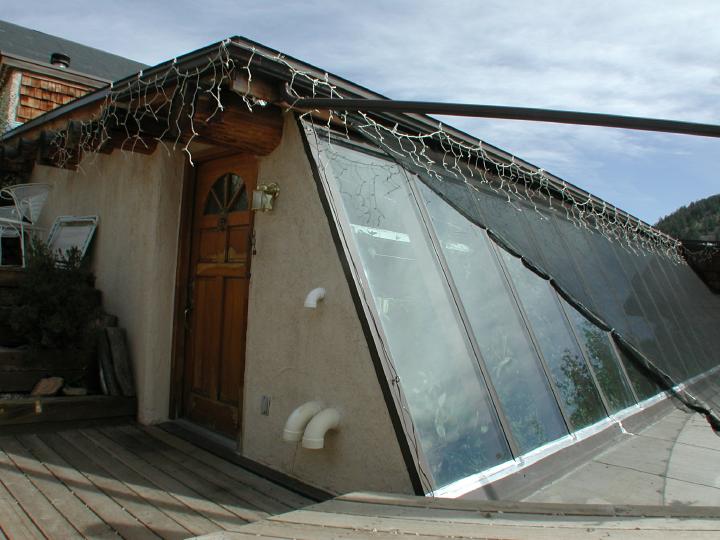
Insulated drapes are a wise addition in cold, cloudy winter climates, but keep in mind that even on a cloudy day your home gets some solar gain. The triangular space between drape and glass serves as a very effective moderating space for hot or cold situations. Hot climates dictate you drop the amount of solar gain in the summer, so you cool your thermal mass by installing sun shade materials along the exposed glass front and allow in cooling nighttime breezes Creating a cooler micro-climate outside the home with a shaded trellis is key to any home design: shade cloth chapter. Commercial greenhouses use knitted shade panels that vary with climate and amount of sun you are trying to block. The effect is predictable with sun blockage translating into cooling for the home interior. Knit shade material pictured above is a 30 percent sun blockage. Shade canopies are typically simple horizontal installations over a standard wood or metal pipe trellis. Angled shade sail shown above is a unique approach for illustration of a more minimalist approach. Normally, a trellis is constructed.
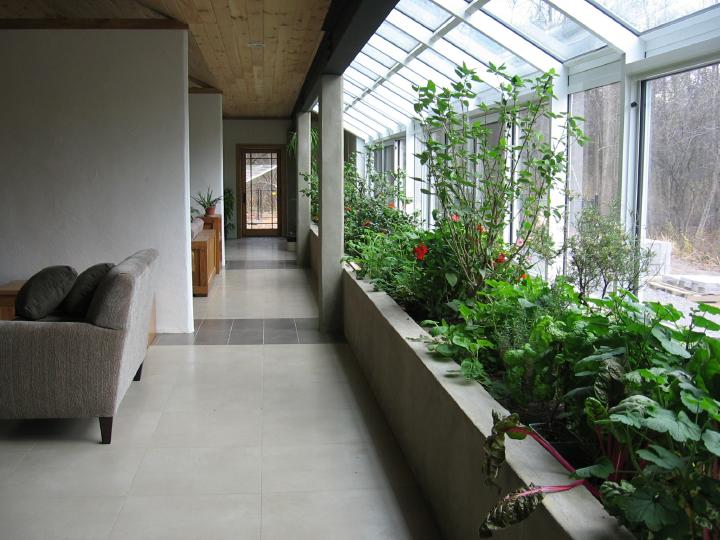
Healthy, well-maintained planter beds function in-balance, keeping insects in check. Flies are very rarely a problem and any other resident insects tend to keep to themselves in the soil. Key is to monitor and address issues with Dr. Bronner's soap rinses before infestations can take hold. Should an aphid problem get out of control, and you do not wish to use insecticides (organic or otherwise), ultimately one may have to remove all plants and tightly cover moist soil with black plastic for a couple of weeks to "bake" their eggs. If you continue to have aphid issues after replanting, changing plant selection to chrysanthemums and succulents is a low-maintenance solution since the problem may be the type of plants being grown and not necessarily the planter bed itself. Succulenta and plants with waxy leaves tend to be the most insect resistant.
Dwarf citrus trees do quite well in greenhouses. Key is to select plants which thrive in moderate light settings since shading is generally needed in the summer months to avoid overheating in most climates. Dwarf fig trees, for instance, have proven to be very well suited to indoor plantings and are insect resistant. Tropical house plants tend to do especially well since they enjoy warm temperatures, average humidity, and moderate light which are typical conditions for indoor green spaces.
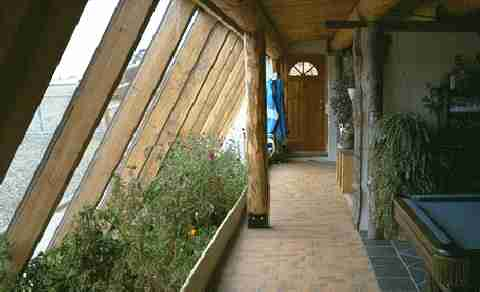
The burlap fence shown here along front of below-grade planterbed was a temporary solution to the problem of dog hair in the tomato patch. We replaced the fabric fence with cobblestone edging bricks for a more finished look. If you ever line a hallway planter bed with bricks, don't set them in mortar. Edging brick cleanup is a whole lot easier when they're move-able; you just take them outside and hose them off. Ultimately, best practice is a raised planter bed versus the floor level planter pictured here. Raised planters are much easier to work from a seated position.
Here's a look at a south face design sketch which incorporates a shed roof and a full overhang past the sloped glass. Overhang designs still manage to generate full solar gain during the peak heating months while providing generous amounts of shade in the summer. One advantage of this particular overhang design is that the shade cloth can now be hung vertically across the front of the posts instead of horizontally, awning style, out in front of the home. This is but one example of the type of design choices you will have with your HTM. Don't be lead to believe that the home you see on this site is the only design possible, there is very little limit to your choices. For example, you'll notice that the roof shown here is sketched as being built with standard BCI joists instead of T&G planks and logs. This sketch outlines a very deep frostwall. Some parts of the country call for frostwalls to extend up to four feet below the finished grade.
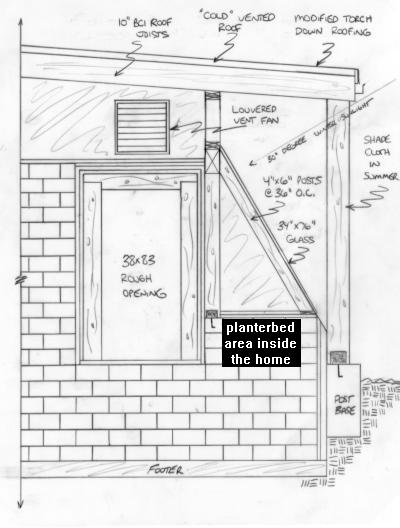
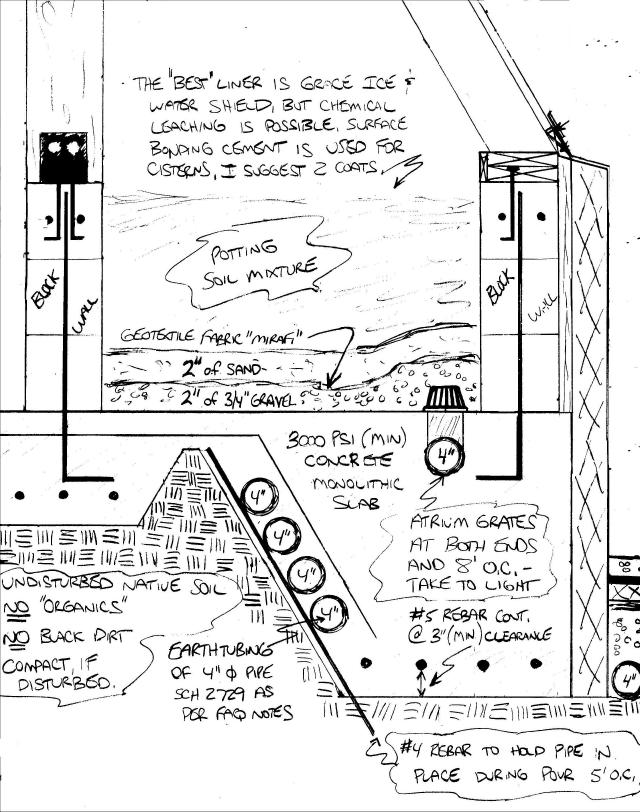
Wood planter box designs benefit from our heavy-duty woven geotextile soil filter fabric. Polypropylene will never rot in wet soil or break down when not exposed to direct sunlight. LIfetime service in any planter box. For a natural fiber, you can try several layers of burlap, but it will rot and fails to slow root infiltration. Ornamental planterbeds line the bottom and insides with Grace Ice and Snow roofing underlayment to render it waterproof, then drill 3/8 inch diameter weep holes in corners and every foot on center, then line the bottom of planterbox with geofabric, add a couple of inches of nominal 1/2 inch gravel in base for drainage, and then install geofabric, continuous from bottom and running up all four sides. Staple the geofabric in place with fuzzy side facing the soil. When growing vegetables, avoid bitumen underlayment waterproofing. Multiple layers of linseed oil can be used for a more natural approach. For an Organic planterbed, do not use 'Boiled' linseed oil since it contains metallic dryers to accelerate curing. Boiled linseed oil is basically Raw linseed oil plus some 'Japan Drier' for polymerization, oxididation, and hardening of the oil coat. Japan drier is lead-free, but with 97% Naphta and 3% Cobalt compounds.
As shown below, exterior planterbeds are constructed in much the same way as interior planterbeds. These exterior planterbeds have direct roof gutter irrigation in addition to greywater recycling options. Root infiltration is kept to a minimum and the pipes easily installed by simply laying the leach field perforated pipes upon tilled soil and covering with at least six inches of mulch and/or gravel as per local code and/or your sustainable irrigation needs. Bricks under the pipe every couple of feet will help ensure even distribution by keeping the entire leach field level. We recommend avoiding a layer of landscaping fabric under the distribution pipes. Fabric will help prevent root infiltration, but the resulting bio-mat negates any long-term benefit. The best advice we can offer for low-maintenance, passive irrigation is to not glue the distribution pipe fittings. Simply sliding pipes together without glue allows you to easily disassemble, clean the pipes, and remove any root infiltration.
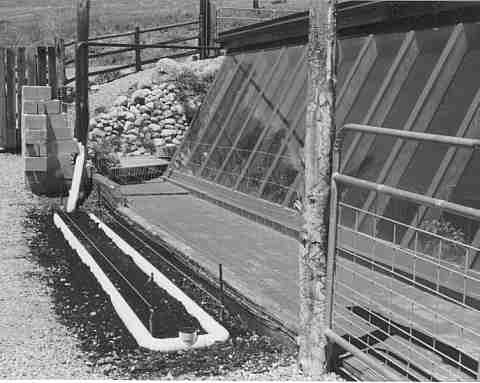
In the photo below, you can see where we are installing a layer of landscaping fabric above the irrigation pipes to keep weeds from growing in between the trees and shrubs (those sickly looking sticks). The west side planterbed shown above was not fitted with landscaping fabric as a comparison. As expected, we found that the landscaping fabric was unnecessary with a deep enough mulch layer to block weed growth. In fact, the landscaping fabric was a nuisance as soon as it started to decompose. Twenty years later and we have not had to dismantle the leach field pipes yet to remove root infiltration. We suspect that it may never be required.
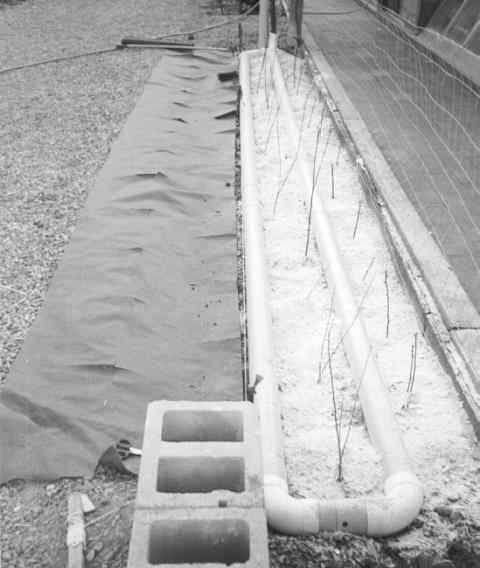
An orchard is typically the best use of greywater with a small tree easily uptaking 15 plus gallons per day and the pipes do not need to be pressurized. Please take this link to a detail page with typical greywater leach field sketches. With this style of system, the drywells are acting as emergency overflow leaching pits where the majority of greywater being delivered directly to your orchard trees.
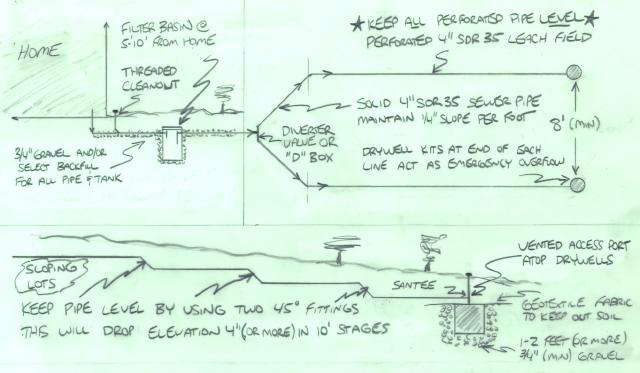
HTM Passive Solar eBook – Table of Contents
- introduction to high thermal mass pragmatic design, low-tech functions, and materials
- photo gallery is packed with images, commentary, and our free HTM Home Tour video
- dry stack surface bonding cement construction photos and some block layout sketches
- floor plans features several functional basic layouts and commentary on design choice
- roof detail chapter with T&G plank-style vented roof decking atop log purlin joist beams
- sun screens critical passive solar design component to create favorable micro-climates
- heat storage fiberglass water tanks are a low-tech way to moderate temperature swings
- earth tubing is simple passive technique to temper a household’s fresh air return intake
- solar orientation isn’t critical since HTM designs excel in hot or cold climates anywhere
- exterior fascia SBC coatings over EPS foam board insulation and sloped glazing details
- wing insulation and shallow footer, frost-protected perimeter foundation design choices
- planter beds are a central, functional component of greenhouse-style HTM construction
- links page is filled with a helpful selection of research references and relevant websites
Last updated on November 1st, 2023

